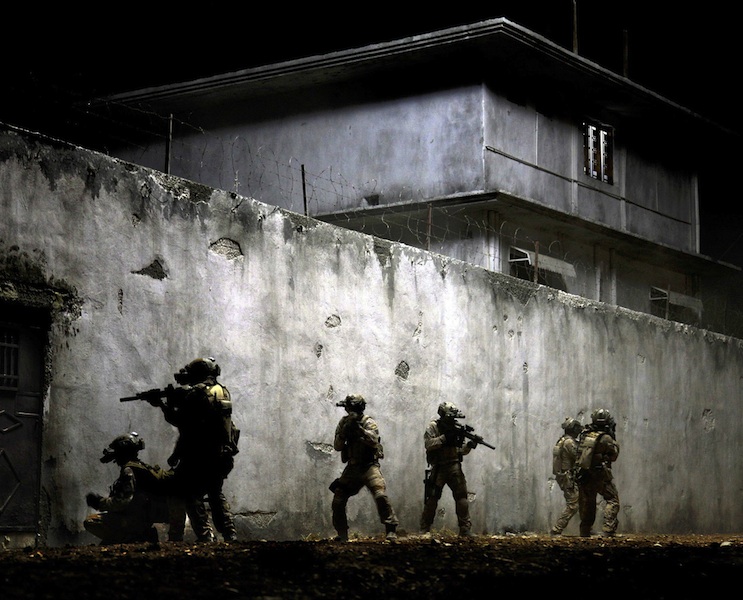The 2011 raid that left Osama bin Laden and four other people dead inside a Pakistani compound inspired book chronicles, glossy magazine features and an Academy Award-winning movie — yet, some of the most salient details of the operation have remained shrouded in mystery.
It was ostensibly for those reasons that the Pakistani government set up a commission in June 2011 to shed light on the key unanswered questions regarding the fateful early May evening and the time period leading up to it. On Monday, Al Jazeera published an exclusively obtained copy of the findings from the Abbottabad Commission. According to Al Jazeera, the report “was buried by the government and never made public” after it was finished in May 2012.
Here are eight of the most fascinating details from the Commission’s report.
Bin Laden Immediately Recognized The Incoming Helicopters As American.
The report set the scene of the dramatic night. Bin Laden had been spending the evening with Amal Ahmad Abdul Fattah al-Sadah, a 29-year-old Yemeni woman who was the youngest of the international fugitive’s three wives. The two originally thought the commotion outside was an incoming storm and went on the balcony to investigate, but the moonless sky made the outdoor surroundings pitch black. When Sadah reached to turn on a light, bin Laden said, “No!”
After reciting the Kalma — the Muslim declaration of faith — and verses from the Quran with some of his children, bin Laden told his family that American helicopters had arrived and urged them to leave his room.
Search Of Bodyguard’s Wife Turned Violent.
Ibrahim al-Kuwaiti, a Pakistani man who served as one of bin Laden’s bodyguards at the compound, was shot and killed by U.S. forces after hearing a knock on his door that he thought was from his brother, Abrar, the terrorist’s courier. Abrar was also fatally shot during the raid.
Kuwaiti’s wife, Maryam, was shot and wounded during the raid. Later, when Maryam resisted efforts to comply with an American body search, things turned aggressive. According to the report, Maryam cursed at the Navy SEALs conducting the raid, prompting them to slap her.
Americans Left With Bin Laden’s Will, Leaving Its Contents Unknown.
The Americans gathered a number of items before leaving the compound, including a purse that evidently contained the will of the Al-Qaeda leader. Since then, there have been disputed reports on what the will did or did not say.
Bin Laden’s eldest wife, Khairiyyah Sabar, is quoted in the report as saying that the will was apolitical and dealt only with familial matters. But “she did not wish to divulge the details,” according to the report. Other accounts have suggested that bin Laden used the will to assert that his children should not assume leadership positions with Al-Qaeda, the report noted.
Osama In A Cowboy Hat.
Bin Laden kept very few articles of clothing in the compound, despite having spent six years hiding in Abbottabad. His wardrobe included three pairs of pants for the summer, three for the winter, a black jacket and two sweaters.
Bin Laden’s wives told the Commission that “he was not fond of possessions.” But his wardrobe evidently also included a cowboy hat, which bin Laden wore when he moved about the compound in order to “avoid detection from above.”
A Compound Divided.
According to the Commission, “there was in fact a wall separating” bin Laden’s family from the families of Ibrahim and Abrar. Their children never played with each other and the families did not “mix or socialize.”
The report detailed one account in which Ibrahim’s daughter saw a picture of bin Laden on Al Jazeera, leading her to recognize him as the “Miskeen Kaka” (“poor uncle”) who lived upstairs. Panic-stricken, Ibrahim attempted to bar the women from watching television, but his wife demanded an explanation. He eventually relented and admitted that the man living upstairs was in fact bin Laden.
The Skinny On OBL, KSM.
Bin Laden is said to have lived in Haripur, Pakistan, before re-locating to Abbottabad. While in Haripur, the report indicated that bin Laden did not host any guests — an apparent result of his decision to terminate all contact with “Al-Qaeda fellow Mujahideen” in the wake of the 2003 arrest of suspected 9/11 mastermind Khalid Sheikh Mohammed. But bin Laden maintained electronic communication with Qaeda operatives, which ultimately enabled U.S. intelligence to track him.
Mohammed introduced Ibrahim to bin Laden, the report notes. Mohammed, currently held at the U.S. military detention facility in Guantanamo Bay, Cuba, grew up with Ibrahim in Kuwait. They were described in the report as being “close as brothers.”
Close Call.
Details in the report on bin Laden’s life in hiding painted a picture of a largely confined, solitary existence with little to no outside activity. But the report provided a glimpse at one episode from his time living in Swat, Pakistan, that occurred sometime in the two years after 9/11.
According to testimony from Maryam, the group was traveling to a nearby bazaar when the car, which was carrying bin Laden, was stopped for speeding. Ibrahim “quickly settled the matter,” the report indicated.
Failures Abound.
Perhaps the biggest takeaway from the report was the across-the-board indictment laid at the feet of Pakistani government and law enforcement –Â incompetence that was labeled “Government Implosion Syndrome” by the Commission. The Commission blasted the government for failing to recognize bin Laden’s nearly decade-long stay in Pakistan. It also criticized the government and law enforcement for their inability to recognize the U.S.-led effort to track down the terrorist, leading to what the panel described as an American “act of war.”
In calling on the country’s leaders to apologize to the Pakistani people for “dereliction of duty,” the report concluded that “political, military intelligence and bureaucratic leadership cannot be absolved of their responsibility for the state of governance, policy planning and policy implementation that eventually rendered this national failure almost inevitable.”










